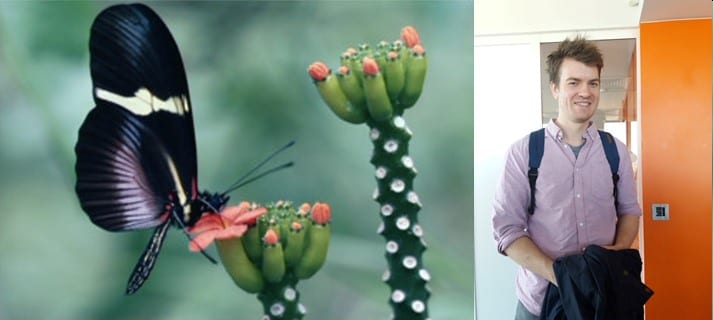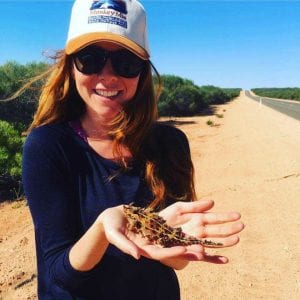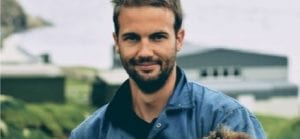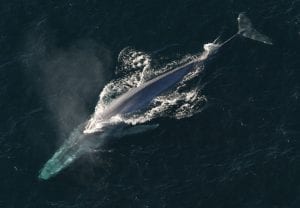During his seminar on Monday, Dr Stephen Montgomery explained how his multi-disciplinary team tackles questions of cognitive adaptation, neuroecology and evolution in butterflies. Coming to us from the University of Cambridge, Dr Montgomery’s presentation was all the more interesting as he will be joining us in the School of Biological Sciences in September.
How does cognition relate to evolution?
This may seem like a daunting question, but Dr Montgomery has made it his career. Whilst initially working on primate brain evolution as part of his PhD, Dr Montgomery now leads a team of scientists studying ecological neurobiology in two clades of Neotropical butterflies, Ithomiini and Heliconiini. His research involves many collaborators and a range of experimental methods.
However, what Dr Montgomery described as “the main story” of his research concerns pollen feeding in Heliconius butterflies. The story begins in the 1970s when Larry Gilbert and colleagues pointed out that Heliconius butterflies were the only butterflies that collect and digest the pollen grains of Cucumis anguria. These pollen grains are the butterflies’ ‘elixir of life’, as they provide rare amino acids, which lead to greater longevity and halt senescence. However, whilst these plants are a reliable food source, they are very sparsely distributed. Gilbert thus concluded that Heliconius learned specific “trap-lines” to attain this food source. Later on, John Sivinski suggested that this enhanced ability for learning and memory is associated with an enlarged region of the insect brain, the mushroom bodies.
Dr Montgomery and his colleagues are now investigating the Heliconius mushroom bodies and their relationship to cognition and evolution.
The Montgomery team started with morphometric analyses of the Heliconius mushroom bodies and compared these to closely related Lepidoptera species. Although the data are not entirely collected yet, Dr Montgomery told us that the Heliconius mushroom bodies are “ridiculously bigger” than in other butterflies.
Whilst it is clear that Heliconius have enlarged mushroom bodies, Dr Montgomery wanted to know if this translated into different processing of sensory information. In an impressive feat of computer modelling, Dr Antoine Couto, a member of Dr Montgomery’s team, produced 3D models of Heliconius brains that suggest the presence of a relatively larger projection zone coming from the ventral lobula, which receives visual information. This would be consistent with the hypothesis that Heliconius learn these “trap-lines” with visual cues.
But Dr Montgomery was not content with a suggestion, he wished to confirm this with a large-scale behavioural experiment. Designing this experiment was challenging as Heliconius seem to only learn visual cues on a large spatial scale. Thus, Dr Montgomery and his team sought out ways to conduct comparative behavioural experiments.
This work is still ongoing, but Dr Montgomery already has pilot data coming from his PhD student Fletcher Young in Panama which explores whether enlarged mushroom bodies are associated with differences in learning performance. For example, Young is testing whether Heliconius can reverse an initial colour preference bias through conditioning training. Heliconius and other closely related butterfly species are being put through this training and after a certain amount of time, they can be assessed to test subjects had retained the information. Therefore enabling a test of whether or not enlarged mushroom bodies are associated with variation in learning and memory traits.
As previously mentioned, Dr Montgomery’s investigation of butterfly cognition is impressive by its scope of different approaches. As part of his team, Dr Francesco Cicconardi and Laura Hebberecht-Lopez are also investigating the developmental process of the Heliconius mushroom bodies. They will be undertaking a comparative developmental study of mushroom bodies across several species to identify the “turning point” which characterises Heliconius’ enhanced cognition.
The study will involve monitoring brain anatomy from larva to adult stages and analysing the corresponding transcriptomes.
Finally, Dr Montgomery expressed his wish to conclude this study by a functional characterisation of the candidate genes associated with the mushroom bodies, although he admitted that it might take them a few years until his team gets there. Nevertheless, his results so far are outstanding. I was particularly impressed with the scope of disciplines that his team unite to offer a solid and complete investigation of insect cognition, to an extent which I had never heard of before.
As usual, the seminar ended with some friendly drinks in our building’s Sky Lounge. Whilst overlooking Bristol on a sunny afternoon, Dr Montgomery expressed his excitement at the prospect of moving to our vibrant city and joining our just as vibrant academic team. I can say without a doubt that the sentiment is reciprocated.
Written by Violette Desarmeaux, Biology (MSci)









